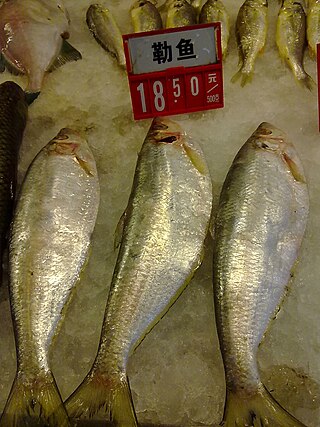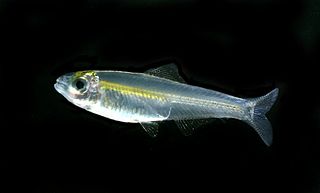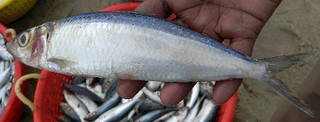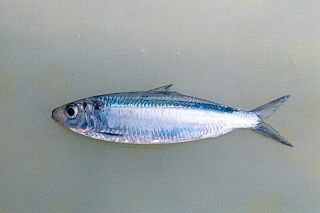
Clupeiformes is the order of ray-finned fish that includes the herring family, Clupeidae, and the anchovy family, Engraulidae. The group includes many of the most important forage and food fish.

Herring are various species of forage fish, mostly belonging to the family of Clupeidae.

The denticle herring is a small, up to 15 cm (5.9 in) long, species of ray-finned fish found only in the rivers of Benin, Nigeria, and western Cameroon. It is related to the herrings, but notable for its large anal fin and its array of denticle-like scales under the head, which give it almost a furry appearance.

Sprat is the common name applied to a group of forage fish belonging to the genus Sprattus in the family Clupeidae. The term also is applied to a number of other small sprat-like forage fish. Like most forage fishes, sprats are highly active, small, oily fish. They travel in large schools with other fish and swim continuously throughout the day.

The Carangidae are a family of ray-finned fish that includes the jacks, pompanos, jack mackerels, runners, trevallies, and scads. It is the largest of the six families included within the order Carangiformes. Some authorities classify it as the only family within that order but molecular and anatomical studies indicate that there is a close relationship between this family and the five former Perciform families which make up the Carangiformes.

Sardinella is a genus of fish in the family Dorosomatidae found in the Atlantic, Indian and Pacific Ocean. They are abundant in warmer waters of the tropical and subtropical oceans. Adults are generally coastal, schooling, marine fish but juveniles are often found in lagoons and estuaries. These species are distinguished by their ranges and by specific body features, but they are often confused with one another. Fish of the genus have seven to 14 striped markings along the scales of the top of the head. The paddle-shaped supramaxilla bones are characteristic; they separate Sardinella from other genera and their shapes help distinguish species. They have paired predorsal scales and enlarged fin rays.

Bagrichthys is a genus of bagrid catfishes.
The toothed river herring or Papuan river sprat is a species of fish in the family Clupeidae. It is found in New Guinea.

Zacco is a genus of small ray-finned fishes in the family Cyprinidae. They are found in freshwater habitats in China and northern Vietnam. The generic name Zacco derives from the Japanese Zako雑魚.
Sardinella richardsoni is a species of ray-finned fish in the genus Sardinella from the South China Sea in the northwest Pacific.

Ilisha is a genus of ray-finned fishes in the family Pristigasteridae. The genus contains 16 species. It is similar to Pellona but lacks a toothed hypo-maxilla. The genus has a worldwide distribution in tropical and subtropical coastal waters and estuaries. Some species also enter rivers, and I. amazonica and I. novacula are largely–if not entirely–restricted to tropical rivers.

Anchovia is a genus of anchovies. It currently contains 3 species. There are found in the eastern Pacific and western Atlantic ocean.

Amblygaster is a small genus of sardinellas in the herring family Dorosomatidae. It currently contains four species. They are found in Indo-West Pacific regions.

Clupeichthys is a genus of sprats, herring-like fishes, that occur in rivers in Southeast Asia. There are currently four recognized species in the genus.

Corica is a small genus of sprats that occur in rivers in South Asia and Southeast Asia. Two described species are placed in the genus.

Doryichthys, river pipefish, is a genus of Asian freshwater pipefishes.

Amblygaster clupeoides, the bleeker smoothbelly sardinella, blue pilchard, sharp-nosed pilchard, or sharpnose sardine, is a reef-associated marine species of sardinellas in the herring family Clupeidae. It is one of the three species of genus Amblygaster.

Amblygaster leiogaster, the smoothbelly sardinella, also known as blue sardine, blue sprat, bluebait, is a reef-associated marine species of sardinella in the herring family Clupeidae. It is one of the three species of genus Amblygaster. It is found in the marine waters along Indo-West Pacific regions south towards western Australia. The fish has 13 to 21 dorsal soft rays and 12 to 23 anal soft rays. It grows up to a maximum length of 23 cm. The flank is gold in fresh fish but becomes black while preservation. Belly is more rounded and scutes are not prominent. It is rather closely resemble Amblygaster clupeoides, but the latter has very few lower gill rakers than smoothbelly sardinella. The fish feeds on minute organisms like zooplankton.

Amblygaster sirm, the spotted sardinella, also known as the northern pilchard, spotted pilchard, spotted sardine, and trenched sardine, is a reef-associated marine species of sardinellas in the herring family Clupeidae.
Anchovia clupeoides, the Zabaleta anchovy, is a species of ray-finned fish in the family Engraulidae. It is found in the western Atlantic Ocean.

















